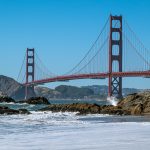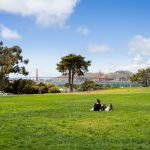San Francisco Military Forts
November 11, 2021The City By The Bay has a long history of military fortresses constructed along its coastline to prevent intruders from entering the San Francisco Bay. No longer used as defense sites, these waterfront forts present picturesque views near some of SF’s premier living opportunities. Visit these well-preserved San Francisco Military Forts to observe the beautiful sights, learn their history, and discover how they continue to honor veterans today!
Take a look at our handy map to view the exact location of each fort in and around San Francisco!
Fort Mason
View this post on Instagram
Positioned within the Marina District next door to the wonderfully-located Marina Cove apartments at 1550 Bay Street, this waterfront fort first originated during The Civil War. Now a beautiful picnic, recreation, and puppy-play area, Fort Mason was once the headquarters for Military Command from California to Hawaii. The former post remains a mix of parks, gardens, and former officer housing used various activities from art galleries to restaurants. Situated directly between Ghiradelli Square and The Marina Green, it is easy to see why the Great Meadow at Fort Mason is such a beloved sunny-day destination.
Fort Point & Fort Scott
View this post on Instagram
Throughout the Civil War, artillerymen stood guard over San Francisco at the eventually constructed Golden Gate Bridge site. Although the Confederate Army planned to attack The City, the war ended before the enemy could reach the Bay Area. Today, much of this defense site remains, as Golden Gate Bridge Chief Engineer Joseph Strauss designed the bridge to preserve and restore Fort Point as a national monument. Most of the area’s barracks and other buildings were moved to higher ground, known as Fort Winfield Scott, but the artillery post was once again renamed Fort Point. With an expansive set of trails, monuments, and Golden Gate Views, Fort Point and Fort Scott are popular with locals and tourists looking to explore The Presidio or catch the sunset across The Pacific Ocean.
Fort Miley
View this post on Instagram
Now the San Francisco Veterans Affairs Medical Center site, Fort Miley was built during the Spanish-American War at Point Lobos to provide a view of ships entering the bay. Situated between Lincoln Park and the Sutro Baths, the coastal defense site later played an important role following the attacks on Pearl Harbor that began WWII. Following its decommission after the war, the area was transferred to the National Park Service. The reservation now features a variety of wheelchair-accessible trails, grassy picnic areas, and Golden Gate views amongst the restored batteries near Lands End.
Fort Funston
View this post on Instagram
San Francisco’s windiest yet most stunning landscape is found within The City’s southwest corner near the San Francisco Zoo. Acquired by the federal government in 1900 as the Lake Merced Military Reservation, this historic fort saw military use up until the Cold War. The region’s steep cliffs allow for an excellent lookout toward the Pacific Ocean, explaining its long-lasting usage for coastal defense. However, instead of watching for enemy ships, you can now enjoy hiking, horseback riding, hang-gliding, and windsurfing at this scenic beach. Fort Funston is also the only park in the Golden Gate National Recreation Area that offers an area for off-leash dogs!
Fort Baker
View this post on Instagram
The City limits of San Francisco aren’t the only nearby location to visit historic San Francisco military forts. Marin County also features multiple scenic defense stations positioned around the Headlands and Angel Island. Fort Baker is found directly opposite Fort Point on the northern side of the Golden Gate Bridge. Much like many of the other Military Forts in San Francisco, Fort Baker was constructed during the Civil War and played a role during both WWI and WWII. The Army maintained the post until the mid-1990s, when it transitioned into the recreation area it is today, along with a Coast Guard Station and the Bay Area Discovery Museum. Located just off the entrance or exit to the bridge, the fort lies within close proximity to the multiple batteries and trails now scattered across the Marin Headlands.
Fort Barry & Fort Cronkhite
View this post on Instagram
Located within the Marin Headlands between Point Bonita Lighthouse and Hawk Hill, Fort Barry is a popular destination for birdwatchers, bikers, hikers, and horseback riders alike. The fort’s hangar is the only of its type that actually housed an Army balloon, and one of only two examples of its type known to survive in the country! A half-mile-long tunnel was built to connect Fort Barry to Fort Baker, with single-lane vehicle and bike traffic now utilizing the tunnel for recreation. The tunnel also leads to Fort Cronkhite and the gorgeous Rodeo Lagoon and Rodeo Beach. Open to the public daily, the area is one of the region’s finest beaches, with camping and surfing both available.
Fort McDowell
View this post on Instagram
Although more difficult to reach than the other military forts around the San Francisco area, Fort McDowell on Angel Island is a must-visit for any history buff or lover of great views! Beginning its military occupation, the entire island was once designated as a base, with a quarantine station opened in Ayala Cove or “Hospital Cove.” The army decommissioned the military post in 1947, and in 1954 a Nike Missile Site was installed on the island. Angel Island is also well-known for its usage as an Immigration Station, with immigrants from 84 different countries entering the US via the island from 1910 to 1940.
San Francisco is surely a city of fascinating military history, and these forts showcase the importance of defending The City’s highly coveted geographical location.
Back to Blog





